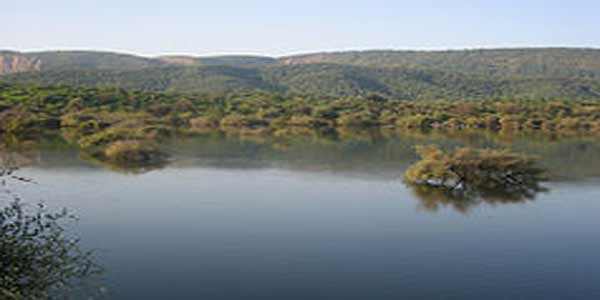

A lake nested within Aravali Hills. Photo: Revolvy
New Delhi, India (BBN) - A pale white carpet of flowers covers the ground under a sinuous climbing vine. The vine twists around a tall tree that branches out into a thick canopy overhead.
A little distance away, a dhau tree creates strange formations with its branches that reach out, within the competitive canopy, for a spot in the sun. From a large humid pit springs emerald green foliage, reports The Hindu.
A fallen tree is colonised by a batch of wildly growing saplings. Trees and shrubs twine together like old people from diverse races.
Only old forests have such distinct tiers of vegetation. The layers are complex, and the plants locked in active and passive competition. No two parts of the forest look the same. This is Mangar Bani, a little woodland shouldering Delhi. Mangar may be small, but its roots are deep. You can feel the forest’s age.
The residents of Mangar village protect this forest patch as a sacred grove. Amid the dust, cement, and the invasive Prosopis juliflora that characterise much of the Aravallis, Mangar stands out as a glistening example of autonomous, community conservation, preserved over tens of generations.
It also stands out as a relict of what the Aravallis — one of the world’s oldest mountains straddling Delhi, Haryana, Gujarat and Rajasthan — once were.
When I visited Mangar, I could hear the trill of a bird from the trees between the loud ricocheting call of peacocks. It was the ‘tree-trew’ of the nine-coloured Indian Pitta.
The Pitta loves forest and undergrowth; and not just any undergrowth, it likes a deep, brown-and-green thicket. The green-wash of monocultures will not do. The Pitta is one of 140-odd species of birds that visit Mangar.
THE LAST ONE LEFT
But the Mangar story — just as the stories of the few remaining forest patches of the Aravallis — is a beleaguered one. Straddling Delhi and Gurgaon, the Aravallis stretch like some rich man’s manor fantasy. From the real estate lens this is perhaps the last bastion that promises flats with a view.
But for the environmentalist and citizen, these last surviving forested nooks are relics that must be preserved. They are after all vital, though punctured, green lungs near Delhi. Citizens have led often lonely and frightening battles to conserve the Aravallis, coming together under various banners. Not to speak of villagers, like those from Mangar, who have fended off several land-grab deals.
Ominously, while Aravalli hill land in Mangar village was originally panchayat land, much of it has become privately owned over the last few decades — a pattern we see in many other villages here. In other pockets of the Aravallis, hills have been mined to dust.
Several parts have been gutted from limestone, silica, quartzite, stone and red sand mining. Mining has created pits so deep they cannot be levelled. Old lakes such as Damdama, Surajkund, Dhauj and Badkhal have virtually dried up. Leopards have been spotted in the area, though their future without forest connectivity looks bleak.
Concerned by the unplanned mining and disturbance, the Supreme Court in 2009 called for an end to mining in the Aravallis. According to the Haryana Forest Department, the green areas and ‘gair mumkin pahad’ (uncultivable land) qualify as forest as per the dictionary meaning of the term, and therefore are ‘deemed-forest’. And according to the National Capital Region Planning Board’s recommendations, the entire Aravallis should fall under a Natural Conservation Zone (NCZ).
Ignoring this, Haryana attempted to give several real estate licences in the Aravallis. This year, the Haryana government refused to accept NCZ restrictions as well as the forest status.
HOPE AGAINST HOPE
If implemented, the NCZ would be a game-changer; with construction limited to just 0.5% of the total area, for regional recreational activities.
In June, petitioner Sarvadaman Singh Oberoi approached the National Green Tribunal against the felling of over 6,000 trees in the Aravallis in Haryana’s Faridabad district. The forest department said the provisions of the Forest (Conservation) Act were applicable to green areas in the Aravallis, where non-forest activity could not be undertaken. The National Capital Region Planning Board has also taken a categorical view that status quo ought to be maintained for 50,000 acres of land in Aravallis.
But despite citizen movements and judicial scrutiny, Bharti Land, a sister concern of Airtel, has felled thousands of trees, for a real estate project named Delhi Ridges. The trees disappeared over a weekend in June, just as quickly as the State’s political will to conserve its ecology waned.
While the National Green Tribunal is hearing the matter, Haryana has said that trees felled were the invasive species Prosopis juliflora. Bharti’s lawyers have argued that the area is not ‘virgin forest,’ implying it would be on the chopping block tomorrow, if not today.
The question that hangs over the imperilled Haryana Aravallis, including Mangar, is: if degraded forests are felled, should flats rise in their place? As for Mangar, it may be managed by villagers, but only an idealist would believe that it is safe. In the next few months the National Green Tribunal may determine the fate of the last of the Aravallis. Will Delhi and Haryana slowly turn their hillsides into green-view farmhouses? Make a Gurgaon out of a Mangar?
BBN/MMI/ANS